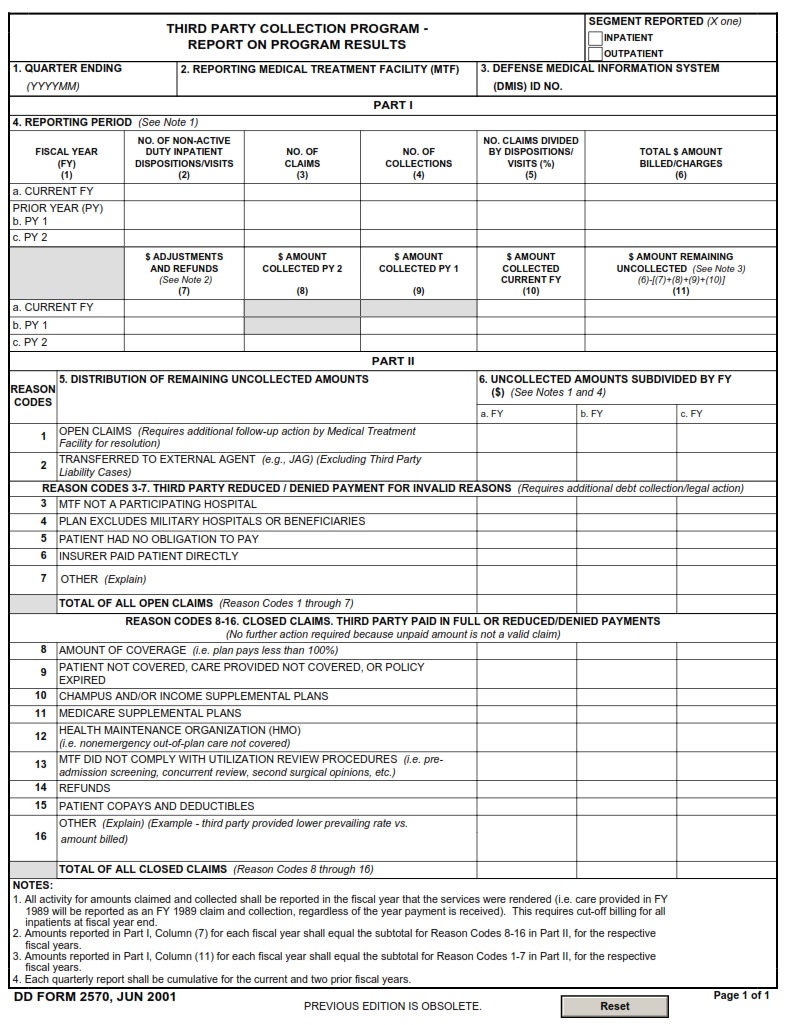DDFORMS.ORG – DD Form 2570 – Third Party Collection Program – Report on Program Results – The DD Form 2570, also known as the Third Party Collection Program, is a tool used by the Department of Defense to collect debts owed by individuals or entities. This program allows the government to work with private collection agencies to recover outstanding debts and bring in much-needed revenue.
A report on program results for the Third Party Collection Program provides valuable insights into how effective this strategy has been in recouping unpaid debts. This article will explore the findings of such a report and examine the impact that this program has had on debt collection efforts within the Department of Defense.
Download DD Form 2570 – Third Party Collection Program – Report on Program Results
| Form Number | DD Form 2570 |
| Form Title | Third Party Collection Program – Report on Program Results |
| Edition Date | 6/1/2001 |
| File Size | 61 KB |
What is a DD Form 2570?
A DD Form 2570 is a document used by the United States Department of Defense (DoD) Third Party Collection Program to report on program results. The form is filled out by the agency or organization responsible for collecting debts owed to the DoD and provides an overview of their efforts, including how much money was collected and what methods were used. The goal of the program is to recover outstanding debts that are owed to the government without resorting to legal action.
The DD Form 2570 includes information on the number of cases referred for collection, how many accounts were resolved, and any challenges or obstacles encountered during the process. Additionally, it provides details on how much money was collected through various methods such as wage garnishment, offsetting tax refunds, or negotiating payment plans with debtors. The report also highlights any trends or changes in collection efforts over time.
Overall, the DD Form 2570 serves as a record-keeping tool for agencies involved in collecting debts owed to the DoD. It helps them track their progress and identify areas where they can improve their efforts in recovering outstanding debts while avoiding litigation wherever possible.
Where Can I Find a DD Form 2570?
DD Form 2570 is a crucial document that serves as a report on program results for the Third Party Collection Program. This program aims to recover debts owed to the federal government by third parties, such as insurance companies, private individuals, and businesses. The DD Form 2570 provides detailed information on the collection efforts made by the government and the results achieved in recovering these debts.
If you need to obtain a DD Form 2570, there are several ways to do so. You can visit your nearest military installation’s legal office or finance office and request a copy of the form. Additionally, you can download it from various online resources provided by the Department of Defense or other reputable websites.
It’s essential to note that any information contained within a DD Form 2570 is confidential and should not be shared with unauthorized persons or entities. Furthermore, it is important to fill out this form accurately and completely since it will impact future collection efforts for outstanding debts owed to the federal government.
DD Form 2570 – Third Party Collection Program – Report on Program Results
The DD Form 2570 serves as a report for the Third Party Collection Program’s results. This program is intended to collect debts owed to the federal government by individuals or entities outside of the government. The form contains information on the amount of debt collected, as well as any costs associated with collecting it.
The report provides insight into how successful this program has been in recovering funds owed to the government and whether it was a cost-effective method of doing so. Analysis of these reports can help identify areas where improvements could be made and determine if changes are necessary in order to achieve better results.
Overall, the DD Form 2570 provides valuable data for evaluating the effectiveness of this program and ensuring that taxpayer dollars are being used appropriately. By using this form to track progress over time, agencies can make more informed decisions about how best to allocate resources toward debt collection efforts.
